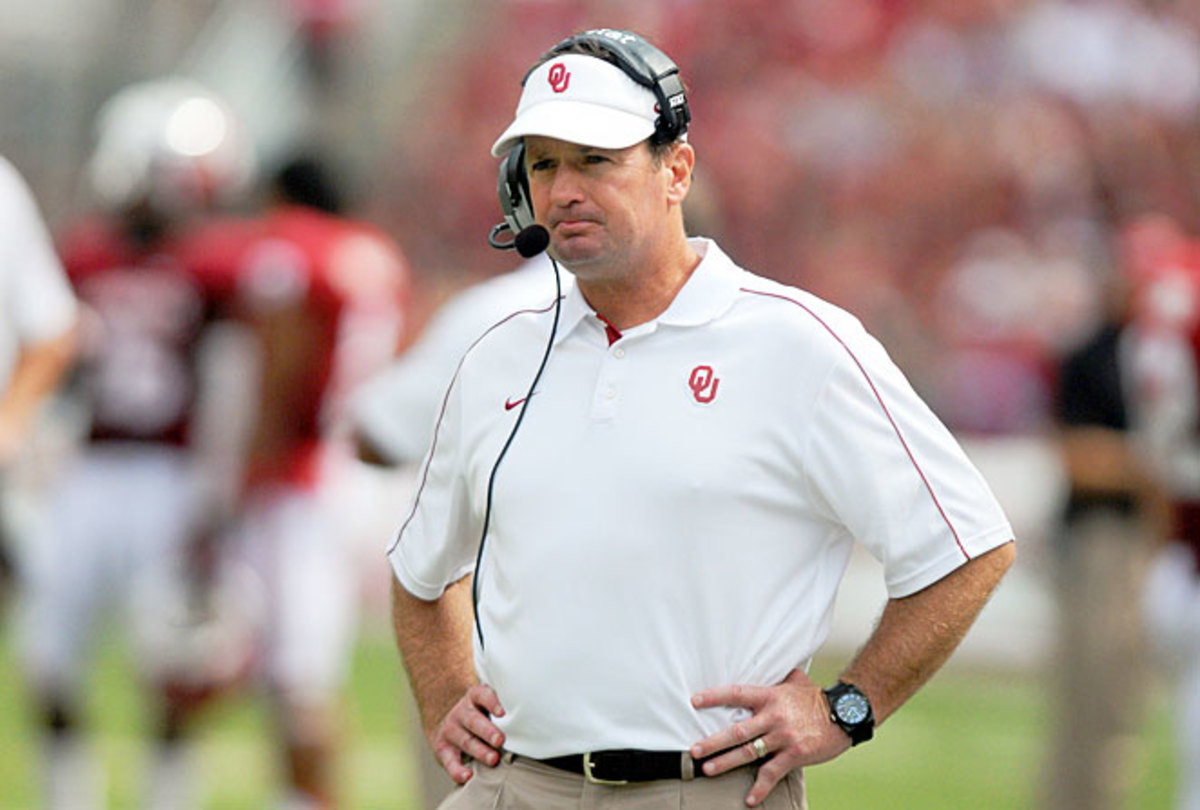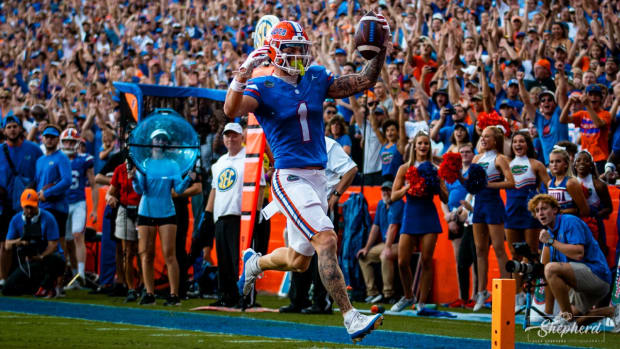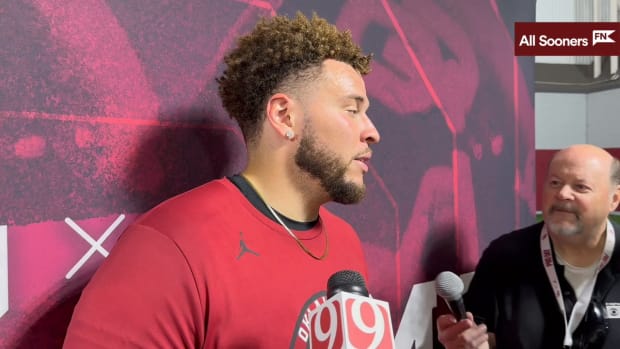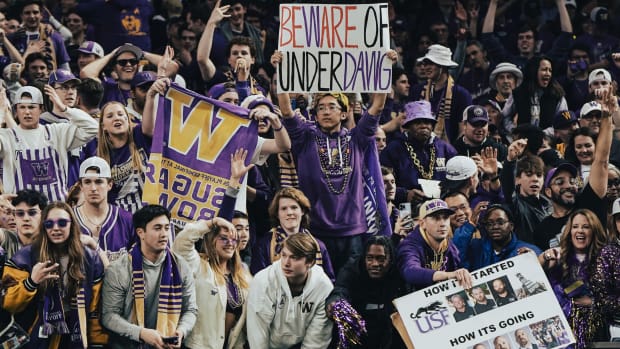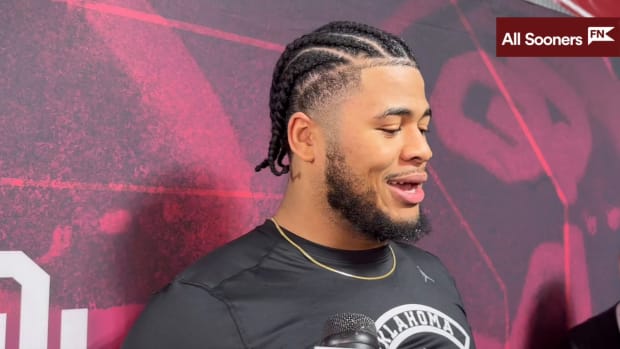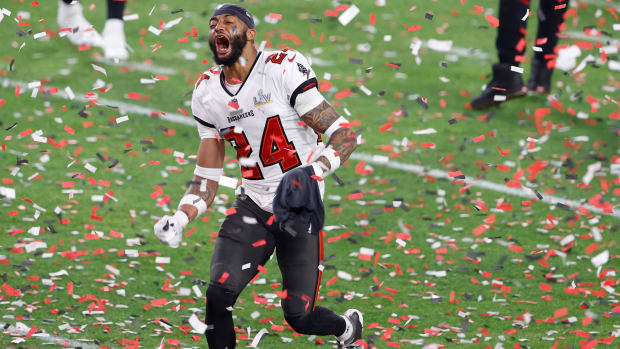Comparing recent performance to preseason hype; more mail
Well, you guys definitely stepped up this week. There was no shortage of great questions to choose from. Maybe it's a sign that spring football really is upon us (I'll be making my first practice visits this week and next), or maybe you got really bored during the Oscars. Or maybe you watched the Oscars and thought to yourself, hmm, it's too bad Stewart doesn't do a Mailbag Crush anymore because Jennifer Lawrence would make just about the perfect candidate. She's beautiful and talented and all that, but also endearingly hilarious, bitingly sarcastic and just plain un-movie star-like. Oh well, I guess he only writes about football now.
Stewart, in 10 out of the last 12 years, Oklahoma has finished lower in the final polls than it was ranked in the preseason polls, the most of any FBS school. Is this because Oklahoma has been a constant underachiever, or have the expectations simply been too high? And which major school (Kings and Barons) would you say has underachieved most over the last decade or so?-- Mike, Norman, Okla.
My initial reaction upon receiving Mike's e-mail was to e-mail him back to ask where he found that stat. He pointed me to Chris Stassen's excellent compilation of preseason data, which I've used as a reference many times, but, I must reluctantly confess, did not realize included a very interesting table (going back to 1989) that shows frequently rated teams' annual performance relative to preseason expectations. Much to my surprise, Oklahoma checks in as the biggest underperformer of all. (Note that prior to it's unexpected BCS title berth last season, Notre Dame, a more expected choice, would have been the biggest underperformer.)
If you look at the chart, nearly all the teams (Michigan, Nebraska, Florida State, Texas, USC) at the bottom share a similar arc over the past decade-plus. All won national championships within the last 15 years and have spent most of the time since chasing that fading heyday. But pollsters have long memories. They live under the perennial assumption these traditional powers will eventually return to prominence, that they can't possibly stay down for too long. Poll voters see the caliber of recruits these teams bring in and are willing to give them a bigger benefit of the doubt than, say, Oregon, which -- despite its recent dominance -- does not have nearly the same history as those others (and has thus outperformed expectations seven of the last eight years).
But Oklahoma's case feels a little bit different. Bob Stoops set the bar incredibly high when he won a national championship in his second season at the helm (exceeding its consensus preseason ranking by 20 spots, no less) and then returned to the championship game three times in an eight-year span. There's nothing underachieving about eight 11-win seasons in 10 years (2001-10). Only in the past two seasons does it feel like Stoops' program has actually started to fall short of expectations (and even then it went 10-3 both times). The 2011 team had no business losing at home to Texas Tech and ending up in the Insight Bowl, and last year's team basically held serve, losing to the elite foes it faced (Kansas State, Notre Dame and Texas A&M) while beating up on Texas and handling the rest of the Big 12. The Sooners have played at a high level, but the expectations have been even higher. It's no coincidence that Stoops recently initiated the biggest staff shakeup of his tenure, jettisoning three assistants (including original staff member Jackie Shipp), all of whom coached linemen. The new hires (most recently West Virginia's Bill Bedenbaugh and Michigan's Jerry Montgomery) indicate an emphasis on improving recruiting, an area where Oklahoma has noticeably slipped of late.
As for the second part of the question, regarding which King has underachieved the most over the past decade or so, without question it's Florida State. With the incredible amount of talent in FSU's backyard and a near-annual spot in the top 10 of most recruiting rankings, the 'Noles should rarely be far from national title contention (especially given their relatively undemanding ACC competition). Yet, last year marked their first top-10 finish since 2000 (and even that included an unforgivable loss at NC State). The preseason prognosticators' continued infatuation with FSU even after repeated disappointments has become a running joke, but in reality, the 'Noles should be better. Last year's 12-2 team in coach Jimbo Fisher's third season finally offered evidence that things may really be changing in Tallahassee -- but Florida State still finished four spots lower than predicted, according to Stassen's data. And it's had to replace seven assistants this offseason. The good news is expectations may actually be a tad lower than usual in 2013.
Didn't the NCAA just pass some new rules last fall saying a head coach will be held responsible for violations by his staff? If so, then how can the president of the NCAA (Mark Emmert) basically say "I knew nothing" in regard to the Miami mess and have that be OK? When will the rest of the NCAA wake up and realize they need someone new to head the organization?-- Matt, Manassas, Va.
I've seen this analogy used a lot in the days since the NCAA released the findings of its external enforcement review in the Miami case, and while I've been critical of Emmert dating to dictatorial takedown of Penn State, I don't agree this is an apples-to-apples comparison. A head coach still has layers of bosses above him, the athletic director and university president, whereas Emmert is the president. In the case of Miami, VP of enforcement Julie Roe Lach was closer to the equivalent of a head coach. She reports to Emmert, and she did in fact take the fall for a failure by her staff. To say Emmert should be held responsible for misconduct by the enforcement staff is like saying a university president should be fired for violations committed by an assistant basketball coach.
However, there are a lot of people in the college athletics world questioning Emmert's leadership -- a sentiment that stems from the overall direction of the NCAA under his watch. Last weekend the NCAA's Executive Committee issued a "unanimous" vote of confidence, citing "academic reforms, enhanced fiscal accountability and organizational transparency" since Emmert has been president. Those are all well and good, and it's not surprising that a group of university presidents would maintain support for one of their own. The problem is Emmert and his advisors seem to be operating in a bubble separate from the actual people (coaches, ADs, commissioners) involved in college sports on a day-to-day basis. Where is the "fiscal accountability" in the recent rules deregulation championed by Emmert that is already spawning a new arms race among football powers to assemble expensive, bloated recruiting staffs? Where's the organizational transparency in conducting secret, unprecedented negotiations with Penn State's president to enact crippling sanctions he can't appeal? How can the NCAA staff work with any sense of security given the unprecedented turnover that's taken place since Emmert arrived?
I don't think it's fair to pin all of the NCAA's problems on Emmert. He inherited most of them. But if you do want to use the coaching analogy, Emmert's tenure thus far feels a lot like Rich Rodriguez's stint at Michigan. There were issues there before he arrived, but in his effort to correct them, he wound up creating more. The organization/program may ultimately turn itself around, but there's only so much turmoil it can withstand before a change in leadership becomes inevitable.
Hi Stewart, love the insights you provide in the Mailbag. What do you think of the Big Ten's apparent decision (if Barry Alvarez is correct) to preclude any future gridiron dates with FCS schools? I have mixed feelings -- Appalachian State's upset of Michigan was one of the greatest college football events in the last 10 years, but typically these games are horrific to watch and offer no strength of schedule boost for the FBS school involved. What are your thoughts on the trend, if it indeed comes to fruition?-- Doctor Dave, San Marcos, Texas
Alvarez's comments (on his radio show) sure got a lot of mileage, but from what I've been told, no such ban is on the table yet. It's true that both Jim Delany and his league ADs have talked openly about the need to upgrade nonconference schedules. That's partially anticipation of the new playoff system and its purported emphasis on strength of schedule (including the fact undefeated Ohio State last year might have missed the playoff due to the weak state of the conference), and it's partially a league-wide admission that it can no longer put anyone on the schedule and assume its teams will still sell out their stadiums. But I don't think the end result will be an across-the-board ban on FCS opponents.
For one thing, it's financially impractical. Programs with big stadiums will still want at last seven home games. Even with nine conference games and a marquee home-and-home, teams are still going to need at least one "guarantee" game. It already costs upwards of $1 million to book a low-level FBS foe, and those numbers will get even higher if FCS is not an option. For another, some teams' schedules may actually become worse if forced to replace upper-tier FCS teams (like Appalachian State) with bottom-of-the-heap FBS foes. Tennessee, for instance, would have fared better in Sagarin's ratings last season had it replaced No. 103 Troy (Sun Belt) with No. 72 Georgia Southern (FCS). And finally, this proposal wouldn't be fair to FCS programs that depend heavily on the paycheck from guarantee games to fund their entire athletic department. My guess is you'll see the Big Ten schedule fewer guarantee games in general, which will include fewer FCS foes, but not a unilateral ban.
Have you heard anything in regard to the SEC increasing its strength of schedule, like the Big Ten, and whether it's considering increasing conference games or doing away with FCS opponents?-- Keith Walker, Grand Prairie, Texas
Nope. The current approach is working pretty well for them.
How do you feel about the NCAA rules committee's proposed "Boise State rule" mandating that either a team's jersey or pants must contrast the color of the playing field? I don't have a large-screen TV or all the bells and whistles, but I have always been able to see who did what when Boise State has worn blue on blue. I just don't get it.-- Dan Nelson, Boise
I don't really care about the rule one way or another, but I do find it positively hilarious that the Mountain West, after initially invoking this rule two years ago, not only dropped it to help persuade Boise to stay but is now protesting to the NCAA on the Broncos' behalf. Writes commissioner Craig Thompson: "...this regulation could have a significant negative marketing impact for the Broncos. It will also likely result in undesirable publicity for the NCAA, and would most certainly be damaging to the Boise State University brand."
On the list of issues causing "undesirable publicity" for the NCAA right now, something tells me this is somewhere around 8,548th.
Stewart: Don't you think that Johnny Football taking all of his classes online this semester is a little bit fishy? It seems to me that student-athletes should be required to attend at least a majority of their classes on campus.-- Richard, Coppell, Texas
While it certainly clashes with our traditional image of the college experience, I can't get worked up over something millions of regular college students are already doing. According to the Sloan Consortium, 32 percent of college students were taking at least one online course as of fall 2011. Mind you, that number doesn't differentiate between those at traditional schools like Texas A&M and new-age for-profit schools that may exist online only, but most major universities offer vast online programs at this point. So if Johnny Manziel is doing something that 6.7 million other college students do to some degree, who am I to say, "How dare he?"
I also don't doubt it's a mob scene every time he tries to walk to class. When I visited Michigan last August, Taylor Lewan told me about having to "block" for Denard Robinson due to all the autograph and picture seekers wherever he went. Robinson didn't seem to mind, but he'd been in the limelight for three years by then. Manziel was largely anonymous until six months ago. Now, he's entered a realm of celebrity few, if any, previous college athletes have ever experienced. It's one thing to be a star; it's another to be hobnobbing with LeBron James, Megan Fox, Justin Timberlake, Jessica Biel, the Jonas Brothers and assorted other sports and entertainment figures. (It's a shame, though, that as best I can tell he has not yet met the wondrous Jennifer Lawrence.) Manziel may be a Texas A&M student, but his experience has morphed into something entirely different than any of his classmates. I wouldn't call it fishy; it's just a new frontier.
Here's a hypothetical for you to fill the quiet period between Signing Day and offseason arrests. Nick Saban (I use Saban as an example but this could apply to coaches at most of the top programs) has won national championships at two programs and is a top recruiter. Let's say Saban quits tomorrow to take a job at Wyoming. How do you think Saban would perform outside a traditional powerhouse school with first-class facilities? Will his coaching and recruiting abilities negate Wyoming's disadvantages? Or, at the end of the day, will Wyoming will still be Wyoming and Alabama still be Alabama?-- Sean, Dublin, Ireland
We already have a couple of reference points with which to answer this, seeing as Saban previously coached at Toledo and Michigan State. He went 9-2 in his one season with the Rockets (1990), which, at the time, tied for the school's most wins in 19 years. Saban was a modest 34-24-1 at Michigan State (1995-99), though his winning percentage (.585) was the highest of any coach in East Lansing since the mid-'70s. He didn't reach the elite level until he went South, where future first-round defensive linemen are more plentiful, oversigning rules are less restrictive and resources are seemingly unlimited. And yet, his tenures still followed a familiar pattern. At LSU, he notched a higher winning percentage (.750) than four coaches before him. At Alabama, he's on the nearly the exact same pace (.829) as Bear Bryant (.824). The six coaches between them managed a combined .617 mark.
So it's safe to say that if Saban went to Wyoming, he would quite quickly have the Cowboys playing well above their historic clip of .470. That's partially because he'd be able to lure a few top-flight recruits who know he can help get them to the NFL, but it's mostly because The Process is proven to work. But no, Wyoming would not start winning national championships. Besides the program's near-total lack of history, its resources are a fraction of Alabama or LSU's, and there's no natural recruiting area from which to draw. The closest hotbed would be Texas, and even that's 500 miles just to get to the northernmost border. You might say he could at least turn Wyoming into the new Boise State, but even Boise has considerable advantages over Laramie, Wyo. (It's easier to get to and a short flight from Northern or Southern California.)
So to sum up this fun little exercise, Saban would definitely take Wyoming to new heights, but there'd still be a ceiling. Realistically, they'd become a regular bowl team rather than one that's been to three bowls in the 2000s.
Stewart, I am glad that you're continuing to produce the Mailbag while college football is on hiatus. Perhaps you could use this time to reverse the approach, and you can ask readers to write in their opinions on questions you are interested in. I think your questions might be a lot more interesting and thought provoking than those from an average fan.-- Chuck, Cincinnati
You know what? I do have some questions. Thanks for the idea. In the wake of this week's SI cover, I'm interested in how closely you (the readers) follow spring football. So I'm conducting another reader survey like the one I did last August, only this time I was smart enough to automate the result tabulation. I'll share my findings next time.
